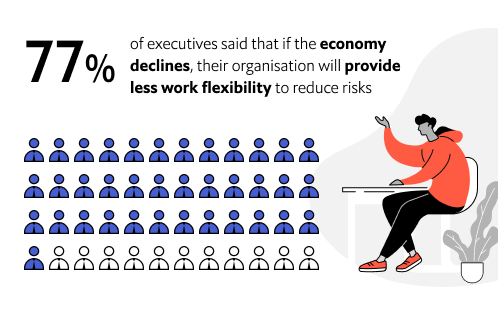Keeping people at the centre
Following Year 1 of the Making hybrid work human programme, Economist Impact, supported by Google Workspace, conducted an updated global survey, which informed the creation of a first-of-its kind flexible work barometer. The barometer measures companies’ progress on the adoption, implementation and evaluation of flexible work models.
Download report 2023
This year’s global survey encompassed more than 900 executives across four regions and seven industries in April-May 2023, and sought to explore the current state of flexible work, as well as executive attitudes about the future of flexibility. The barometer confirms that executives are confident that flexibility improves wellbeing and performance. However, it also shows that organisational challenges persist. Some high-level key findings are as follows:
Flexibility is here to stay
The vast majority (90%) of surveyed organisations offer both flexible working hours and location options to some or all employees. This contrasts from the pessimism of the knowledge workers surveyed in 2021, as only roughly 50% said they expected their organisations to continue offering time and location flexibility post-pandemic.
2021
2021
expected their organisations to continue offering time and location flexibility post-pandemic
2023
2023
of surveyed organisations offer both flexible working hours and location options to some or all employees.
Our flexible work barometer scores varied widely, ranging between 30 and 84 out of 100, with a global average of 65.
Within the four pillars of the barometer, culture (measured on trust, employee autonomy and commitment to diversity) stands out as a problem area across regions, industries and company sizes.
Global average
 55
55Culture and strategy
 62
62Evaluation and improvement
 65
65Implementation
 70
70Work policy design
Flexible work “leaders” score higher than “laggard” organisations across the barometer’s four key pillars:
Culture and strategy, work policy design, implementation, and evaluation and improvement. A key difference that sets leaders apart? Prioritising employee wellbeing.
Leaders
Laggards
Overall score
Culture and strategy
Work policy design
Implementation
Evaluation and improvement
Leaders
Overall score
Culture and strategy
Work policy design
Implementation
Evaluation and improvement
Laggards
Notably, compared with laggards, leader organisations are experiencing greater culture-related challenges, including decreased trust between managers and direct reports, and disconnection between new hires and existing employees. As they have dived head-first into flexible work, it seems there has not been enough emphasis on building a conducive flexible work culture.
Solutions for making flexible work succeed should focus on strengthening workplace culture via four key areas: management, trust, connection and collaboration.
Many executives view technology-related deficits as being among the top obstacles to implementing more flexible work policies.
50% of executives say that basic tools that facilitate formal and informal collaboration (like online messaging platforms, online documents and project management software) are only rarely/sometimes used; tech cited in top 5 challenges to flexible work adoption.
However, advanced technology could also prove beneficial.

However, advanced technology could also prove beneficial.
The overwhelming majority (~84%) of leaders believe that artificial intelligence (AI) has significant potential to support flexibility, innovation and creativity.
While the advancement of flexible work is fluid and complex, these findings suggest that the companies thriving in this new era of work are those that keep humans at the centre and prioritise strong connections, creativity and collaboration.
Cluster analysis on survey data about AI and its effects on the future of work identified diverging viewpoints
Executives have diverging viewpoints that could determine the role of AI in corporate strategy moving forward. The majority are “ahead of the curve” and are optimistic about AI’s effects on workers and the workplace both now and in the future. A smaller group of executives prefer to “wait and see” as they do not envision AI benefitting workers positively and worry about cybersecurity.
Explore more

How do your flexible working practices compare?
Take our short assessment to benchmark your progress against other organisations.

The new era of work
Explore what business leaders said about the current state of flexible work -- and its main benefits and challenges.

